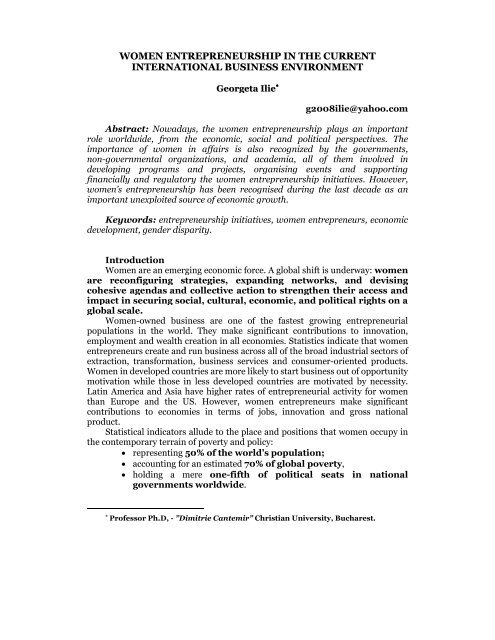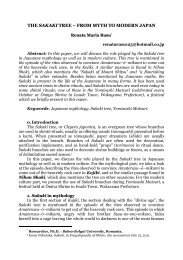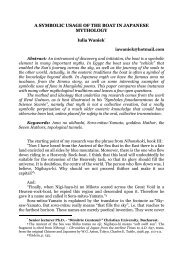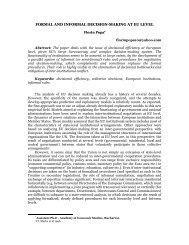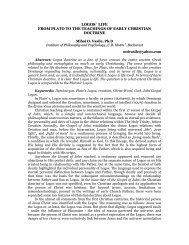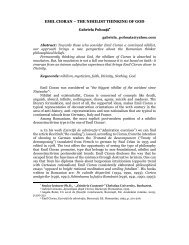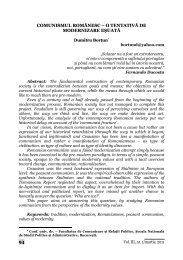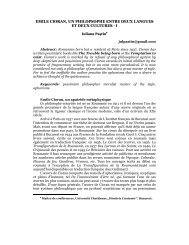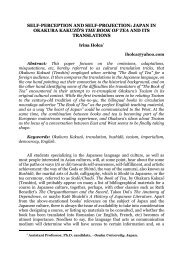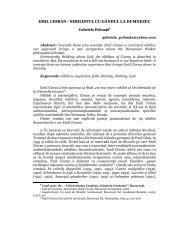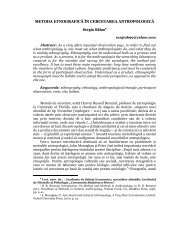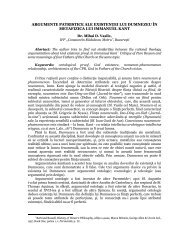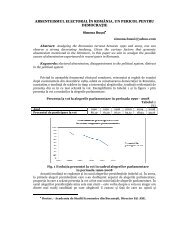women entrepreneurship in the current international business ...
women entrepreneurship in the current international business ...
women entrepreneurship in the current international business ...
You also want an ePaper? Increase the reach of your titles
YUMPU automatically turns print PDFs into web optimized ePapers that Google loves.
WOMEN ENTREPRENEURSHIP IN THE CURRENT<br />
INTERNATIONAL BUSINESS ENVIRONMENT<br />
Georgeta Ilie ∗<br />
g2008ilie@yahoo.com<br />
Abstract: Nowadays, <strong>the</strong> <strong>women</strong> <strong>entrepreneurship</strong> plays an important<br />
role worldwide, from <strong>the</strong> economic, social and political perspectives. The<br />
importance of <strong>women</strong> <strong>in</strong> affairs is also recognized by <strong>the</strong> governments,<br />
non-governmental organizations, and academia, all of <strong>the</strong>m <strong>in</strong>volved <strong>in</strong><br />
develop<strong>in</strong>g programs and projects, organis<strong>in</strong>g events and support<strong>in</strong>g<br />
f<strong>in</strong>ancially and regulatory <strong>the</strong> <strong>women</strong> <strong>entrepreneurship</strong> <strong>in</strong>itiatives. However,<br />
<strong>women</strong>’s <strong>entrepreneurship</strong> has been recognised dur<strong>in</strong>g <strong>the</strong> last decade as an<br />
important unexploited source of economic growth.<br />
Keywords: <strong>entrepreneurship</strong> <strong>in</strong>itiatives, <strong>women</strong> entrepreneurs, economic<br />
development, gender disparity.<br />
Introduction<br />
Women are an emerg<strong>in</strong>g economic force. A global shift is underway: <strong>women</strong><br />
are reconfigur<strong>in</strong>g strategies, expand<strong>in</strong>g networks, and devis<strong>in</strong>g<br />
cohesive agendas and collective action to streng<strong>the</strong>n <strong>the</strong>ir access and<br />
impact <strong>in</strong> secur<strong>in</strong>g social, cultural, economic, and political rights on a<br />
global scale.<br />
Women-owned bus<strong>in</strong>ess are one of <strong>the</strong> fastest grow<strong>in</strong>g entrepreneurial<br />
populations <strong>in</strong> <strong>the</strong> world. They make significant contributions to <strong>in</strong>novation,<br />
employment and wealth creation <strong>in</strong> all economies. Statistics <strong>in</strong>dicate that <strong>women</strong><br />
entrepreneurs create and run bus<strong>in</strong>ess across all of <strong>the</strong> broad <strong>in</strong>dustrial sectors of<br />
extraction, transformation, bus<strong>in</strong>ess services and consumer-oriented products.<br />
Women <strong>in</strong> developed countries are more likely to start bus<strong>in</strong>ess out of opportunity<br />
motivation while those <strong>in</strong> less developed countries are motivated by necessity.<br />
Lat<strong>in</strong> America and Asia have higher rates of entrepreneurial activity for <strong>women</strong><br />
than Europe and <strong>the</strong> US. However, <strong>women</strong> entrepreneurs make significant<br />
contributions to economies <strong>in</strong> terms of jobs, <strong>in</strong>novation and gross national<br />
product.<br />
Statistical <strong>in</strong>dicators allude to <strong>the</strong> place and positions that <strong>women</strong> occupy <strong>in</strong><br />
<strong>the</strong> contemporary terra<strong>in</strong> of poverty and policy:<br />
• represent<strong>in</strong>g 50% of <strong>the</strong> world’s population;<br />
• account<strong>in</strong>g for an estimated 70% of global poverty,<br />
• hold<strong>in</strong>g a mere one-fifth of political seats <strong>in</strong> national<br />
governments worldwide.<br />
∗ Professor Ph.D, - ”Dimitrie Cantemir” Christian University, Bucharest.
Yet <strong>the</strong>se same numbers have a tendency to obscure <strong>the</strong> character and<br />
context of potential expressed <strong>in</strong> <strong>the</strong> lives of <strong>women</strong>, of <strong>the</strong> attributes and agility<br />
<strong>women</strong> have <strong>in</strong> mak<strong>in</strong>g vital contributions to <strong>the</strong>ir respective communities, and <strong>in</strong><br />
shap<strong>in</strong>g <strong>the</strong> features of participatory democracy.<br />
In emerg<strong>in</strong>g markets across <strong>the</strong> world, <strong>women</strong> are expand<strong>in</strong>g <strong>the</strong>ir<br />
<strong>in</strong>volvement <strong>in</strong> bus<strong>in</strong>ess and stimulat<strong>in</strong>g economic development. The voices and<br />
leadership of <strong>women</strong> entrepreneurs are crucial to enlarg<strong>in</strong>g access to opportunity<br />
and <strong>in</strong>vigorat<strong>in</strong>g <strong>the</strong> democratic process.<br />
The Community of Women Entrepreneurs shares ideas, experiences, best<br />
practices, and resources to empower <strong>women</strong> economically and politically. This<br />
community is hosted and moderated by <strong>the</strong> Center for International Private<br />
Enterprise (CIPE). The views expressed by <strong>the</strong> authors are <strong>the</strong>ir own and do not<br />
necessarily represent <strong>the</strong> views of <strong>the</strong> Center for International Private Enterprise.<br />
1. A few characteristics of <strong>women</strong> <strong>entrepreneurship</strong> <strong>in</strong>itiatives <strong>in</strong><br />
Europe<br />
Across different countries <strong>in</strong> Europe, <strong>the</strong>re are some aspects about <strong>the</strong> chance<br />
of <strong>women</strong> becom<strong>in</strong>g entrepreneurs and creat<strong>in</strong>g jobs as compared to men.<br />
Gender differences are large, men be<strong>in</strong>g significantly more likely to choose<br />
self-employment over waged employment and to be job creat<strong>in</strong>g self-employed.<br />
Investigations of <strong>the</strong> data published by Eurostat relieve <strong>the</strong> follow<strong>in</strong>gs: <strong>the</strong><br />
basic reason for <strong>the</strong> differences <strong>in</strong> self-employment rates between men and<br />
<strong>women</strong> are expla<strong>in</strong>ed by differences <strong>in</strong> <strong>the</strong> nature of jobs <strong>the</strong>y enter and<br />
<strong>the</strong> sector <strong>the</strong>y work <strong>in</strong>; childcare and eldercare responsibilities<br />
actually <strong>in</strong>crease <strong>the</strong> probability that <strong>women</strong> will choose self-employment and<br />
create jobs <strong>in</strong> self-employment.<br />
From <strong>the</strong> perspective of cultural, historical, social and economic<br />
reasons, <strong>in</strong> Europe manifest <strong>the</strong> <strong>women</strong> <strong>entrepreneurship</strong> paradox.<br />
Despite Norway pioneer<strong>in</strong>g gender equality, provid<strong>in</strong>g childcare and o<strong>the</strong>r<br />
social services, and a high rate of <strong>women</strong> <strong>in</strong> <strong>the</strong> labour force, <strong>the</strong> share of <strong>women</strong><br />
entrepreneurs rema<strong>in</strong>s relatively low. The gendered construction of<br />
<strong>entrepreneurship</strong> is rooted <strong>in</strong> historical paths and re<strong>in</strong>forced through<br />
contemporary practices, such as <strong>the</strong> gendered division of labour, <strong>the</strong> tendency for<br />
<strong>women</strong> to work part-time and family-friendly politics streng<strong>the</strong>n<strong>in</strong>g <strong>the</strong><br />
connotation of family and domestic tasks as female. These practices <strong>in</strong>fluence <strong>the</strong><br />
likelihood of <strong>women</strong> becom<strong>in</strong>g entrepreneurs and bus<strong>in</strong>ess owners. Interest<strong>in</strong>gly,<br />
<strong>entrepreneurship</strong> is an important part of <strong>the</strong> capitalistic system, and capitalism is<br />
fundamentally gendered.<br />
The some paradox is also obvious <strong>in</strong> F<strong>in</strong>land. Despite labour force<br />
participation, political activity and gender-specific legislation, <strong>women</strong>’s<br />
participation <strong>in</strong> <strong>the</strong> highest level of management and decision-mak<strong>in</strong>g <strong>in</strong> F<strong>in</strong>land<br />
is very low. They argue that encourag<strong>in</strong>g greater <strong>women</strong>’s participation at this<br />
level is important for economic and competitive reasons.<br />
There are a positive and significant correlation between female leadership<br />
and company profitability to speculate. Women go through a tougher<br />
screen<strong>in</strong>g process and, <strong>the</strong>refore, <strong>the</strong> average leadership abilities of
<strong>women</strong> <strong>in</strong> top management may be better than those of <strong>the</strong>ir male<br />
counterparts. A possible explanation is that female leadership may be tied to<br />
<strong>the</strong> culture of organizations where advancement and appo<strong>in</strong>tments <strong>in</strong> <strong>the</strong>se<br />
organizations are based on competence and merits ra<strong>the</strong>r than traditions and<br />
established convention. Although not able to prove causality for <strong>the</strong>ir results, <strong>the</strong>y<br />
suggest that a company may ga<strong>in</strong> competitive advantage by identify<strong>in</strong>g and<br />
elim<strong>in</strong>at<strong>in</strong>g <strong>the</strong> obstacles to <strong>women</strong>’s advancement to top management. 1<br />
2. Women’s political and economic empowerment<br />
Focused on <strong>the</strong> perceived status of <strong>women</strong>, and <strong>in</strong> recognition of <strong>the</strong> barriers<br />
and challenges that constra<strong>in</strong> <strong>women</strong> from maximiz<strong>in</strong>g <strong>the</strong>ir full potential, <strong>the</strong><br />
Centre for International Private Enterprise (CIPE) recently hosted an<br />
<strong>in</strong>ternational conference: Democracy that Delivers for Women, on <strong>the</strong> topic of<br />
<strong>women</strong>’s political and economic empowerment.<br />
This conference cultivated dialogues that move beyond conventional modes<br />
used to assess and understand <strong>the</strong> lives of <strong>the</strong> <strong>women</strong> and <strong>the</strong>ir ability to<br />
impact policy and streng<strong>the</strong>n economies.<br />
The conference drew a group of <strong>women</strong> and men from economic fields,<br />
political landscapes, and organizational sectors, <strong>in</strong> order to:<br />
• identify and share challenges,<br />
• explore <strong>the</strong> attributes and trends <strong>in</strong> <strong>women</strong>’s leadership,<br />
and<br />
• ga<strong>the</strong>r <strong>in</strong>sights for action <strong>in</strong> fuell<strong>in</strong>g a radical shift <strong>in</strong> <strong>the</strong><br />
economic and political empowerment of <strong>women</strong><br />
throughout <strong>the</strong> world.<br />
The overall premise of <strong>the</strong> conference was that <strong>the</strong> economic<br />
empowerment of <strong>women</strong> can drive broader social and political<br />
empowerment.<br />
It is <strong>the</strong> ability to create one’s own step on <strong>the</strong> economic ladder that is<br />
absolutely essential to achiev<strong>in</strong>g social and political rights.<br />
There are many gender-centred trends surface <strong>in</strong> development<br />
organizations and <strong>in</strong>stitutions evok<strong>in</strong>g buzzwords like empowerment and<br />
social change, usually with good <strong>in</strong>tentions. Yet, too frequently <strong>the</strong>se groups fail<br />
to <strong>in</strong>tegrate <strong>the</strong> <strong>in</strong>sights and voices of <strong>women</strong> be<strong>in</strong>g assisted and/or<br />
served, especially when it comes to optimiz<strong>in</strong>g <strong>the</strong> opportunity for <strong>women</strong> to take<br />
active roles <strong>in</strong> <strong>the</strong> decision-mak<strong>in</strong>g process of <strong>the</strong> very <strong>in</strong>itiatives meant to<br />
positively impact <strong>the</strong>ir lives.<br />
CIPE’s conference relieves a def<strong>in</strong>ite push to crack open this paradigm by<br />
mov<strong>in</strong>g <strong>women</strong> to <strong>the</strong> forefront of discussions <strong>in</strong> assess<strong>in</strong>g <strong>the</strong>ir realities,<br />
def<strong>in</strong><strong>in</strong>g <strong>the</strong>ir terms of empowerment, and by widen<strong>in</strong>g <strong>the</strong> space for <strong>women</strong> to<br />
collectively shape viable steps toward substantiat<strong>in</strong>g necessary and vital social<br />
change. The outcomes of <strong>the</strong> conference rema<strong>in</strong> to be seen, though without a<br />
1<br />
Candida G. Brush, Anne de Bru<strong>in</strong>, Elizabeth J. Gatewood, Colette Henry, Women<br />
Entrepreneurs And The Global Environment For Growth, published by Edward Elgar Publish<strong>in</strong>g<br />
Limited, 2010, UK.
doubt a new discussion is underway.<br />
A spirit of cautious optimism describes essential pr<strong>in</strong>ciples for <strong>the</strong><br />
empowerment of <strong>women</strong>, namely access to economic advancement and<br />
political participation. The empowerment, democracy, and free-enterprise are<br />
<strong>in</strong>dissolubly l<strong>in</strong>ked to overcom<strong>in</strong>g some of <strong>the</strong> most daunt<strong>in</strong>g obstacles <strong>women</strong><br />
face <strong>in</strong> mov<strong>in</strong>g out of poverty and ascend<strong>in</strong>g <strong>in</strong>to positions of political<br />
prom<strong>in</strong>ence. Without a doubt, such claims impart a particular notion of<br />
democracy associated with a U.S.-centric approach, a philosophy that<br />
promulgates <strong>the</strong> revolutionary power of free enterprise (and <strong>in</strong>dividualism) as an<br />
essential <strong>in</strong>gredient to achiev<strong>in</strong>g social and political rights.<br />
Assum<strong>in</strong>g a U.S.-centric model, however, risks imped<strong>in</strong>g or overlook<strong>in</strong>g <strong>the</strong><br />
emergence of a non-Western conceptualization of democracy, such as <strong>the</strong> move by<br />
many non-Western governments to reserve parliamentary seats for <strong>women</strong>,<br />
m<strong>in</strong>orities, and religious sects. As documented by Idea International, Uganda<br />
reserves a parliamentary seat from each of <strong>the</strong> nation’s 39 districts, while 33% of<br />
India’s local municipal positions are reserved to promote <strong>women</strong>’s presence <strong>in</strong><br />
government. In <strong>the</strong> U.S., <strong>the</strong>re are no such concessions to empower <strong>women</strong> <strong>in</strong><br />
politics.<br />
In regards to <strong>women</strong>, however, such concerns and scepticism are often<br />
irrelevant. The voices of <strong>women</strong> <strong>in</strong> both economic and political<br />
arenas—regardless of <strong>the</strong> model—rema<strong>in</strong> selectively audible, at best, but for <strong>the</strong><br />
most part <strong>the</strong>ir voices are entirely miss<strong>in</strong>g from <strong>the</strong> negotiat<strong>in</strong>g table. If for<br />
anyth<strong>in</strong>g, this context provides a start<strong>in</strong>g po<strong>in</strong>t for advanc<strong>in</strong>g (pragmatic)<br />
strategies that streng<strong>the</strong>n <strong>women</strong>’s <strong>in</strong>clusiveness and promotes greater gender<br />
equality <strong>in</strong> economic and political decision-mak<strong>in</strong>g roles.<br />
The development of <strong>women</strong> <strong>in</strong> <strong>entrepreneurship</strong> often evolves as a necessity<br />
for gett<strong>in</strong>g through impossible times, and can serve to level <strong>the</strong> power gap<br />
between <strong>the</strong> sexes. More importantly, as revealed <strong>in</strong> some research and work,<br />
<strong>women</strong> <strong>in</strong> enterprise account for one of <strong>the</strong> most under-reported and untold<br />
stories among media and development organizations, claim<strong>in</strong>g that <strong>women</strong> and<br />
enterprise is as much as an economic story as a political story.<br />
Too many times <strong>in</strong> discussions of <strong>women</strong>, <strong>the</strong>re is a separation of<br />
<strong>women</strong>’s economic and political issues, as if <strong>the</strong> functions operate <strong>in</strong><br />
demarcated spheres. This is particularly absurd when we consider that <strong>women</strong>’s<br />
enterprise and labor disproportionately makes up much of <strong>the</strong> <strong>in</strong>formal sector,<br />
largely due to discrim<strong>in</strong>atory policies and practices that complicate <strong>the</strong>ir move<br />
<strong>in</strong>to formal markets. Whe<strong>the</strong>r as a result of cultural or social barriers, beliefs,<br />
stereotypes, ideologies, and/or orthodoxies, each practice prevents <strong>women</strong> from<br />
advanc<strong>in</strong>g (and secur<strong>in</strong>g) <strong>the</strong>ir political and economic rights.<br />
For <strong>the</strong>se reasons alone, it is imperative that any moves toward s<strong>in</strong>cere and<br />
effective cultural and social change for <strong>women</strong> is not spl<strong>in</strong>tered <strong>in</strong>to compet<strong>in</strong>g<br />
issues: economics and politics. There is quantitative data show<strong>in</strong>g that <strong>in</strong>sert<strong>in</strong>g<br />
<strong>women</strong> <strong>in</strong>to politics is important <strong>in</strong> terms of steer<strong>in</strong>g democratic<br />
transparency and reduc<strong>in</strong>g corruption. We need not only consider <strong>the</strong> moves<br />
<strong>women</strong> make <strong>in</strong>to elected position, but also to decipher how are people study<strong>in</strong>g<br />
<strong>women</strong>’s political participation around <strong>the</strong> globe to show how <strong>women</strong> positively
impact democratic processes.<br />
As CIPE plans programs for 2012, <strong>the</strong>y are seek<strong>in</strong>g to expand programs on<br />
<strong>women</strong>’s empowerment. As <strong>the</strong>y do that, it would be great to hear about <strong>the</strong> ideas<br />
for <strong>women</strong>’s empowerment programs that CIPE could support. There are some<br />
<strong>the</strong>mes raised at <strong>the</strong> conference as suggestions for CIPE to focus on go<strong>in</strong>g forward:<br />
1. launch<strong>in</strong>g programs <strong>in</strong> any of <strong>the</strong>se areas;<br />
2. programs <strong>in</strong> any of <strong>the</strong>se areas;<br />
3. o<strong>the</strong>r project ideas for empower<strong>in</strong>g <strong>women</strong> consistent with CIPE’s<br />
mission;<br />
4. o<strong>the</strong>r credible organizations or groups <strong>in</strong> your country that conduct<br />
successful programs <strong>in</strong> <strong>the</strong>se areas and CIPE should consider work<strong>in</strong>g<br />
with <strong>the</strong>m.<br />
3. Women’s participation <strong>in</strong> entrepreneurial activity <strong>in</strong> different<br />
types of economy.<br />
Women’s participation <strong>in</strong> entrepreneurial activity varies widely<br />
across <strong>the</strong> globe, rang<strong>in</strong>g from just over 1.5% to 45.4% of <strong>the</strong> adult <strong>women</strong> <strong>in</strong> an<br />
economy. In <strong>the</strong> factor-driven economies, 19.9% of <strong>women</strong> between <strong>the</strong> ages of 18<br />
and 64 say <strong>the</strong>y are start<strong>in</strong>g or runn<strong>in</strong>g new bus<strong>in</strong>esses. This figure was 9.7% <strong>in</strong><br />
<strong>the</strong> efficiency-driven economies and 3.9% <strong>in</strong> <strong>the</strong> <strong>in</strong>novation-driven economies.<br />
The percentages of entrepreneurs <strong>in</strong> <strong>the</strong> female and male population for each<br />
economy illustrate that <strong>the</strong>re are, on average, more men than <strong>women</strong><br />
entrepreneurs at each economic development level.<br />
The gap between <strong>women</strong> and men decreases with economic<br />
development level, however, and moves from 5.2 percentage po<strong>in</strong>ts lower for<br />
<strong>women</strong> than men entrepreneurs at <strong>the</strong> factor-driven stage to a 4 po<strong>in</strong>t difference<br />
<strong>in</strong> <strong>the</strong> efficiency-driven stage and 3.4 <strong>in</strong> <strong>the</strong> <strong>in</strong>novation-driven stage.<br />
The ratio of female to male entrepreneurs varies considerably across <strong>the</strong><br />
world: from 1:5 <strong>in</strong> <strong>the</strong> Republic of Korea to 6:5 <strong>in</strong> Ghana. This means that for<br />
every five male entrepreneurs <strong>the</strong>re is one female entrepreneur <strong>in</strong> <strong>the</strong> Republic of<br />
Korea but six <strong>in</strong> Ghana.<br />
In <strong>the</strong> factor-driven group, Middle East and North Africa economies have<br />
<strong>the</strong> fewest <strong>women</strong> entrepreneurs relative to men entrepreneurs, with none<br />
report<strong>in</strong>g that more than 1/3 of <strong>the</strong>ir entrepreneurs are female. These economies<br />
also report low overall total entrepreneurial activity rates. In <strong>the</strong> Sub-Saharan<br />
African economies, on <strong>the</strong> o<strong>the</strong>r hand, <strong>women</strong> make up close to, or more than,<br />
half of entrepreneurs. These economies also have high total entrepreneurial<br />
activity rates.<br />
In <strong>the</strong> efficiency-driven group, <strong>the</strong> lowest proportion of <strong>women</strong><br />
entrepreneurs is found <strong>in</strong> Eastern Europe. Russia is an exception, however;<br />
<strong>women</strong> <strong>the</strong>re represent 44% of total entrepreneurs. The Eastern European<br />
economies also tend to exhibit low total entrepreneurial activity rates. The Lat<strong>in</strong><br />
America/Caribbean region shows both a high relative number of <strong>women</strong><br />
entrepreneurs and high total entrepreneurial activity rates.<br />
In <strong>the</strong> <strong>in</strong>novation-driven group, Asia Pacific economies exhibit among<br />
<strong>the</strong> lowest and highest levels of <strong>women</strong>’s <strong>entrepreneurship</strong>, show<strong>in</strong>g <strong>the</strong> most
diverse spread with regard to participation <strong>in</strong> this activity.<br />
Korea and Japan have among <strong>the</strong> fewest numbers of <strong>women</strong><br />
entrepreneurs <strong>in</strong> <strong>the</strong> world and also low ratios of <strong>women</strong> to men entrepreneurs.<br />
Australia, on <strong>the</strong> o<strong>the</strong>r hand, shows both a high level of <strong>women</strong> entrepreneurs and<br />
a high ratio of <strong>women</strong> to men participat<strong>in</strong>g <strong>in</strong> <strong>entrepreneurship</strong>. In <strong>the</strong> efficiency<br />
group, Malaysia also has a high percentage of <strong>women</strong> entrepreneurs. Ch<strong>in</strong>a, and<br />
to a lesser extent Taiwan, show moderately high levels. The U.S./Western<br />
European group ranges from Norway, where one fourth of <strong>the</strong> entrepreneurs are<br />
<strong>women</strong>, to <strong>the</strong> United States, where nearly half are <strong>women</strong>. 2<br />
4. Pro-active position of bus<strong>in</strong>ess <strong>women</strong><br />
It would be unimag<strong>in</strong>able to leave aside <strong>the</strong> many o<strong>the</strong>r important factors<br />
that prepare and tra<strong>in</strong> <strong>women</strong> for successful leadership roles and<br />
effective political participation, such as education and civic<br />
engagement, mentor<strong>in</strong>g and idea networks, associations, and <strong>the</strong><br />
reach of communications. And it would also be a mistake to not remark on <strong>the</strong><br />
multiplier effect of <strong>women</strong> entrepreneurs tak<strong>in</strong>g <strong>the</strong> lead <strong>in</strong> establish<strong>in</strong>g networks<br />
of support that test <strong>the</strong> assumptions and optimize <strong>the</strong>ir opportunities.<br />
Mary Schnack, entrepreneur and founder of Mary Schnack and Associates<br />
and also a national partner of Women Impact<strong>in</strong>g Public Policy, has taken a<br />
pro-active position <strong>in</strong> advocat<strong>in</strong>g for <strong>the</strong> rights of <strong>women</strong>-owned small bus<strong>in</strong>ess <strong>in</strong><br />
<strong>the</strong> U.S. and <strong>in</strong>ternationally, understand<strong>in</strong>g that <strong>in</strong> so many <strong>in</strong>stances <strong>women</strong><br />
do not realize <strong>the</strong>y are leaders, or let alone that <strong>the</strong>y are<br />
entrepreneurs. In witness<strong>in</strong>g <strong>the</strong> level of successes <strong>women</strong> are hav<strong>in</strong>g <strong>in</strong><br />
bus<strong>in</strong>ess—see<strong>in</strong>g that <strong>the</strong>ir lives are chang<strong>in</strong>g for <strong>the</strong> better—Schnack has<br />
embarked on a mission to amplify <strong>the</strong> voices of <strong>women</strong> and to propel leadership<br />
opportunities globally.<br />
Schnack’s advocacy work presents challenges to <strong>the</strong> <strong>in</strong>ternational<br />
development and non-profit community. She asks, “Why do we have to be a<br />
non-profit to do good? Why can’t we do bus<strong>in</strong>ess that also does good?” This<br />
question alone suggests that development agendas miss <strong>the</strong> po<strong>in</strong>t and fail to<br />
understand <strong>the</strong> needs of <strong>the</strong> populations <strong>the</strong>y serve. In particular, local<br />
populations need real markets <strong>in</strong> which to <strong>in</strong>teract, <strong>women</strong> need policy change<br />
and <strong>the</strong> grounds to express <strong>the</strong>ir leadership skills, and both men and <strong>women</strong> need<br />
employment. It may be, Schnack suggests, <strong>the</strong> bus<strong>in</strong>ess sector that can provide <strong>the</strong><br />
grounds for more accountable and beneficial practices, resources, political<br />
<strong>in</strong>fluence, equal access, responsive outcomes, stability, and active political<br />
<strong>in</strong>stitutions. The bus<strong>in</strong>ess sector could be <strong>the</strong> arena where <strong>women</strong> develop <strong>the</strong>ir<br />
skills and provides a space where political leadership and decision-mak<strong>in</strong>g skills<br />
are honed.<br />
As an example, Assilah Al Harthy attests to <strong>the</strong> challenges of <strong>women</strong> do<strong>in</strong>g<br />
bus<strong>in</strong>ess <strong>in</strong> Oman, where social and cultural orthodoxies, coupled with religious<br />
and political practices, fuel gender <strong>in</strong>equality and make it difficult for <strong>women</strong> to<br />
2<br />
GEM 2010 Women’s Report, Global Entrepreneurship Monitor,<br />
http://www.gemconsortium.org
actively participate <strong>in</strong> public and private sectors. For Al Harthy, her concerns do<br />
not rest solely <strong>in</strong> provid<strong>in</strong>g an example for o<strong>the</strong>r <strong>women</strong> to follow. Ra<strong>the</strong>r, <strong>the</strong> goal<br />
should be “to prove yourself and push yourself, to improve, to achieve.” Indeed, Al<br />
Harthy is prov<strong>in</strong>g herself; <strong>in</strong> 2006, with persistence and courage, she founded<br />
Oman’s first private equity firm, Group 6, and has fulfilled an active role as board<br />
representative of <strong>the</strong> Oman Chamber of Commerce and Industry, receiv<strong>in</strong>g<br />
attention from both Forbes and <strong>the</strong> Oman Economic Review for <strong>the</strong> vitality of her<br />
contributions as one of <strong>the</strong> most powerful bus<strong>in</strong>ess<strong>women</strong> <strong>in</strong> <strong>the</strong> Arab World. As<br />
brought forth by Alexandra Wrage, President of <strong>the</strong> anti-bribery compliance<br />
organization TRACE, <strong>women</strong> have an opportunity to “be <strong>the</strong> change <strong>the</strong>y want to<br />
see,” and this requires <strong>women</strong> to take value <strong>in</strong> recogniz<strong>in</strong>g <strong>the</strong>ir attributes as<br />
agents of change.<br />
The historical effects of gender disparity, however, also need to be<br />
addressed, for it rema<strong>in</strong>s a sensitive issue for most <strong>women</strong>. The Executive<br />
Director and Board President of <strong>the</strong> Serbian Association of Managers, Maja<br />
Piscevic, notes that when it comes to gender equality, “Women do not want to talk<br />
about it; we want to be <strong>in</strong> <strong>the</strong> do<strong>in</strong>g. If we talk about it, we admit we are <strong>in</strong>ferior.<br />
If we do not talk about it, we can avoid accept<strong>in</strong>g <strong>the</strong> disparities of power.”<br />
Accord<strong>in</strong>g to Piscevic, this is not only a result of <strong>the</strong> discrim<strong>in</strong>atory challenges<br />
<strong>women</strong> face <strong>in</strong> economic and political spheres, or solely with<strong>in</strong> gender relations,<br />
she also believes that one of <strong>the</strong> biggest problems <strong>women</strong> contend with “is <strong>in</strong> our<br />
heads,” and just as important for <strong>women</strong> to prioritize “<strong>the</strong> work with<strong>in</strong>, <strong>the</strong> work<br />
on ourselves” to streng<strong>the</strong>n our commitments (as much as realiz<strong>in</strong>g our visions),<br />
to engage <strong>in</strong> be<strong>in</strong>g ourselves, and to accept ourselves, <strong>in</strong>dependently of polariz<strong>in</strong>g<br />
forces.<br />
In essence, <strong>women</strong> are no longer wait<strong>in</strong>g for change. Instead, <strong>women</strong><br />
are tak<strong>in</strong>g leadership <strong>in</strong> becom<strong>in</strong>g <strong>the</strong> change that <strong>the</strong>y envisage. As<br />
demonstrated across diverse sectors at CIPE’s conference, <strong>women</strong> (and men) came<br />
toge<strong>the</strong>r to explore and identify cutt<strong>in</strong>g edge strategies for collective action that can<br />
effectively widen <strong>the</strong> channels of access for <strong>women</strong> <strong>in</strong> atta<strong>in</strong><strong>in</strong>g economic and<br />
political empowerment. Through bus<strong>in</strong>ess associations and entrepreneurial<br />
networks, <strong>women</strong> are engag<strong>in</strong>g <strong>in</strong> learn<strong>in</strong>g experiences, facilitat<strong>in</strong>g strategies for<br />
dialogue and <strong>in</strong>teraction, assert<strong>in</strong>g best practices, and hon<strong>in</strong>g organizational skills<br />
that will enact democratic practices that deliver. Women are reconfigur<strong>in</strong>g<br />
opportunity, activat<strong>in</strong>g <strong>the</strong> power of associations, discover<strong>in</strong>g <strong>the</strong> tactical usefulness<br />
of knowledge and idea shar<strong>in</strong>g, identify<strong>in</strong>g and foster<strong>in</strong>g leadership from with<strong>in</strong>,<br />
steer<strong>in</strong>g <strong>the</strong> policy community to reth<strong>in</strong>k <strong>the</strong> roles of <strong>women</strong> <strong>in</strong> <strong>the</strong> public and private<br />
sectors, and stress<strong>in</strong>g <strong>the</strong> necessity to align policy with actual changes.<br />
This is a high-stakes agenda that can put optimism to <strong>the</strong> test.<br />
Whe<strong>the</strong>r policy or visible change comes first is relative: <strong>women</strong> are no<br />
longer a special <strong>in</strong>terest group or categorically 50% of <strong>the</strong> world’s<br />
marg<strong>in</strong>alized population—<strong>women</strong> are social agents transform<strong>in</strong>g <strong>the</strong><br />
landscape, dedicated <strong>women</strong> <strong>in</strong> leadership pass<strong>in</strong>g <strong>the</strong> baton,<br />
technical geniuses, creative forces, diverse, and <strong>in</strong>tense.<br />
Out of necessity, <strong>women</strong> are <strong>in</strong>novat<strong>in</strong>g opportunity. Free enterprise is an<br />
essential resource for enabl<strong>in</strong>g <strong>women</strong> to ascend to positions of leadership and
mobilize broader social change.<br />
5. Global <strong>women</strong>’s economic empowerment <strong>in</strong>itiatives<br />
Worldwide, <strong>the</strong>re is a variety of economic empowerment <strong>in</strong>itiatives for<br />
<strong>women</strong>. Between <strong>the</strong>m, it stands Walmart <strong>in</strong>itiative. In 2011, Walmart<br />
management launched a major <strong>in</strong>itiative that will use <strong>the</strong> company’s global size<br />
and scale to help empower <strong>women</strong> across its supply cha<strong>in</strong>.<br />
Work<strong>in</strong>g over <strong>the</strong> past year with leaders from government, non-governmental<br />
organizations (NGOs), philanthropic groups and academia, Walmart’s global<br />
<strong>women</strong>’s economic empowerment <strong>in</strong>itiative has established five goals by <strong>the</strong><br />
end of 2016:<br />
1. Increase sourc<strong>in</strong>g from <strong>women</strong>-owned bus<strong>in</strong>esses. Over <strong>the</strong><br />
next five years, <strong>the</strong> company will source $20 billion from<br />
<strong>women</strong>-owned bus<strong>in</strong>esses <strong>in</strong> <strong>the</strong> U.S. and double sourc<strong>in</strong>g from<br />
<strong>women</strong> suppliers <strong>in</strong>ternationally.<br />
2. Empower <strong>women</strong> on farms and <strong>in</strong> factories through<br />
tra<strong>in</strong><strong>in</strong>g, market access and career opportunities. New<br />
programs will help 60,000 <strong>women</strong> work<strong>in</strong>g <strong>in</strong> factories that supply<br />
products to Walmart and o<strong>the</strong>r retailers develop <strong>the</strong> skills <strong>the</strong>y need to<br />
become more active decision-makers <strong>in</strong> <strong>the</strong>ir jobs and for <strong>the</strong>ir<br />
families. The <strong>in</strong>itiative will also help <strong>women</strong> farm workers participate<br />
more fully <strong>in</strong> <strong>the</strong> agriculture supply cha<strong>in</strong>.<br />
3. Empower <strong>women</strong> through job tra<strong>in</strong><strong>in</strong>g and education.<br />
Successful retail tra<strong>in</strong><strong>in</strong>g programs will be scaled to help 200,000<br />
<strong>women</strong> <strong>in</strong>ternationally. In <strong>the</strong> U.S., Walmart will help 200,000<br />
<strong>women</strong> from low-<strong>in</strong>come households ga<strong>in</strong> job skills and access higher<br />
education.<br />
4. Increase gender diversity among major suppliers. The<br />
company will work with major professional service firms and<br />
merchandise suppliers with over 1 billion USD <strong>in</strong> sales to <strong>in</strong>crease<br />
<strong>women</strong> and m<strong>in</strong>ority representation on Walmart accounts.<br />
5. Make significant philanthropic giv<strong>in</strong>g toward <strong>women</strong>’s<br />
economic empowerment. The company will support <strong>the</strong>se<br />
programs with more than 100 million USD <strong>in</strong> grants that drive<br />
progress aga<strong>in</strong>st key goals. Fund<strong>in</strong>g will come from <strong>the</strong> Walmart<br />
Foundation and donations directly from Walmart’s <strong>in</strong>ternational<br />
bus<strong>in</strong>esses.<br />
6. 2011 World’s Most Powerful Women List<br />
Historically, <strong>entrepreneurship</strong> has been a male-dom<strong>in</strong>ated pursuit, but many<br />
of today's most memorable and <strong>in</strong>spirational entrepreneurs are <strong>women</strong>.<br />
In 2011, Forbes Magaz<strong>in</strong>e released its annual list of <strong>the</strong> World’s Most<br />
Powerful Women. With nearly half of power <strong>women</strong> com<strong>in</strong>g from <strong>the</strong> bus<strong>in</strong>ess<br />
sector, an <strong>in</strong>crease of over last year’s 39, bus<strong>in</strong>ess<strong>women</strong> are prov<strong>in</strong>g to be a force<br />
to consider with.<br />
There were <strong>in</strong> fact several changes to <strong>the</strong> 2011 list, <strong>in</strong>clud<strong>in</strong>g new additions<br />
and higher rank<strong>in</strong>gs of return<strong>in</strong>g power <strong>women</strong>, but one th<strong>in</strong>g that has not
changed much is <strong>the</strong> presence, or lack <strong>the</strong>reof, of bus<strong>in</strong>ess<strong>women</strong> from emerg<strong>in</strong>g<br />
markets. Of <strong>the</strong> 49 bus<strong>in</strong>ess<strong>women</strong> on Forbes’ list, a mere seven stem from<br />
emerg<strong>in</strong>g markets, and similar to last year only one, Kiran Mazumdar-Shaw, is<br />
an entrepreneur.<br />
So why is <strong>the</strong>re such a void when it comes to recogniz<strong>in</strong>g powerful <strong>women</strong><br />
from emerg<strong>in</strong>g markets? Is it simply because <strong>the</strong>re are no examples to be found?<br />
On <strong>the</strong> contrary, <strong>in</strong> recent months <strong>the</strong>re have been several accounts of <strong>women</strong>,<br />
particularly <strong>in</strong> <strong>the</strong> Middle East and North Africa, who are controll<strong>in</strong>g more wealth,<br />
exert<strong>in</strong>g <strong>the</strong>ir presence <strong>in</strong> boardrooms, and establish<strong>in</strong>g <strong>the</strong>ir vital role <strong>in</strong> spurr<strong>in</strong>g<br />
economic growth. But <strong>in</strong>stead of dom<strong>in</strong>at<strong>in</strong>g <strong>the</strong> Powerful Women list – perhaps a<br />
consequence of Forbes’ methodology which relies on revenues, media presence,<br />
and spheres of <strong>in</strong>fluence – <strong>the</strong>se lesser known, but no doubt powerful, pioneer<strong>in</strong>g<br />
bus<strong>in</strong>ess<strong>women</strong> cannot seem to make <strong>the</strong> cut.<br />
Dur<strong>in</strong>g <strong>the</strong> Democracy that Delivers for Women conference <strong>in</strong> June 2011,<br />
Center for International Private Enterprise (CIPE) shared <strong>the</strong> stage with three<br />
such bus<strong>in</strong>ess<strong>women</strong> who have not only demonstrated success <strong>in</strong> <strong>the</strong>ir fields, but<br />
also <strong>the</strong>ir ability to serve as leaders <strong>in</strong> <strong>the</strong>ir community.<br />
Founder and President of <strong>the</strong> Bangladesh Women Chamber of Commerce<br />
and Industry (BWCCI) Selima Ahmad has worked with numerous trade<br />
organizations throughout Bangladesh and has a held various top management<br />
positions <strong>in</strong> a number of companies. In addition to her work with BWCCI, she is<br />
<strong>current</strong>ly serv<strong>in</strong>g as Vice Chair of <strong>the</strong> Nitol-Niloy Group.<br />
Dr. Shehla Javed Akran is founder and President of <strong>the</strong> <strong>in</strong>ternationally<br />
recognized Central & North Punjab Women Chamber of Commerce and Industry<br />
(CNPWCCI), Vice President of <strong>the</strong> Federation of Pakistan Chambers of<br />
Commerce and Industry, and was <strong>the</strong> first woman to serve on <strong>the</strong> Executive<br />
Committee of <strong>the</strong> Lahore Chamber of Commerce and Industry. Outside of her<br />
work with Pakistani Chambers she is a successful bus<strong>in</strong>esswoman who most<br />
recently became <strong>the</strong> CEO of real estate development company, JS Developers.<br />
Omani bus<strong>in</strong>esswoman, Assilah al Harthy was <strong>the</strong> first woman <strong>in</strong> <strong>the</strong> Oman<br />
Chamber of Commerce and Industry and more recently became <strong>the</strong> first person,<br />
man or woman, to found a private equity firm <strong>in</strong> Oman. It should also be noted<br />
that Assilah is no stranger to Most Powerful lists, hav<strong>in</strong>g been named one of <strong>the</strong><br />
most powerful Omani bus<strong>in</strong>ess<strong>women</strong> <strong>in</strong> 2008 and 2010 by <strong>the</strong> Oman Economic<br />
Review and one of <strong>the</strong> top 50 most powerful <strong>women</strong> <strong>in</strong> <strong>the</strong> Arab World <strong>in</strong> 2006 by<br />
none o<strong>the</strong>r than Forbes Magaz<strong>in</strong>e.<br />
While <strong>the</strong>se <strong>women</strong>, and many just like <strong>the</strong>m, may not have <strong>the</strong> same sphere<br />
of <strong>in</strong>fluence or media recognition as say German Chancellor Angela Merkel or<br />
enterta<strong>in</strong>er Lady Gaga (both appear on <strong>the</strong> Forbes list <strong>in</strong> separate categories),<br />
<strong>the</strong>y are <strong>the</strong> embodiment of power <strong>women</strong> <strong>in</strong> bus<strong>in</strong>ess from emerg<strong>in</strong>g markets.<br />
7. Associations of bus<strong>in</strong>ess<strong>women</strong> <strong>in</strong> Romania<br />
The Association of Bus<strong>in</strong>ess<strong>women</strong> and Top Managers (AFAFCI) <strong>in</strong> Romania<br />
– which aims to become one of <strong>the</strong> ma<strong>in</strong> representatives of <strong>the</strong> local bus<strong>in</strong>ess<br />
community for <strong>women</strong> – is <strong>current</strong>ly work<strong>in</strong>g with an experienced association<br />
executive to identify <strong>the</strong> needs and values of <strong>the</strong> organization’s 39 members.
Created <strong>in</strong> 2004 with CIPE support, <strong>the</strong> Coalition of Women’s Bus<strong>in</strong>ess<br />
Associations from Romania has built a sound reputation for itself over <strong>the</strong><br />
years, and is now acknowledged as a credible partner <strong>in</strong> <strong>the</strong> public-private<br />
dialogue on economic policy-mak<strong>in</strong>g. The Coalition has a rotat<strong>in</strong>g secretariat and<br />
2011 marks <strong>the</strong> beg<strong>in</strong>n<strong>in</strong>g of a new secretarial mandate, which has been conferred<br />
upon <strong>the</strong> Association of Women Entrepreneurs <strong>in</strong> Romania, which is based <strong>in</strong> <strong>the</strong><br />
city of Galați.<br />
8. Conclusion<br />
Bus<strong>in</strong>ess ownership has great importance for future economic prosperity.<br />
Bus<strong>in</strong>ess ownership provides <strong>women</strong> with <strong>the</strong> <strong>in</strong>dependence <strong>the</strong>y require and with<br />
economic and social success <strong>the</strong>y need. Worldwide, <strong>women</strong> are enhanc<strong>in</strong>g,<br />
direct<strong>in</strong>g, and chang<strong>in</strong>g <strong>the</strong> face of how bus<strong>in</strong>ess is done today. Female<br />
bus<strong>in</strong>ess owners must be recognized for who <strong>the</strong>y are, what <strong>the</strong>y do,<br />
and how significantly <strong>the</strong>y impact <strong>the</strong> world’s global economy.<br />
In a world of rapid change, all entrepreneurs must have <strong>the</strong> flexibility and<br />
creativity to meet <strong>the</strong> changes <strong>the</strong>y face. The national bus<strong>in</strong>ess associations and<br />
policymakers of <strong>the</strong> world can no longer ignore <strong>the</strong> burgeon<strong>in</strong>g power of <strong>women</strong> <strong>in</strong><br />
<strong>the</strong> world economy. Encourag<strong>in</strong>g that realization and help<strong>in</strong>g it take root sooner<br />
ra<strong>the</strong>r than later must be our major goal for <strong>the</strong> new millennium.<br />
Although <strong>the</strong> <strong>in</strong>creas<strong>in</strong>g significance of <strong>women</strong> entrepreneurs, <strong>the</strong>y are<br />
understudied. The result is that we know comparatively little about <strong>women</strong><br />
entrepreneurs even though <strong>the</strong>y contribute positively to gross national product,<br />
jobs, <strong>in</strong>novations and societal welfare globally.<br />
REFERENCES<br />
1. Candida G. Brush, Anne de Bru<strong>in</strong>, Elizabeth J. Gatewood, Colette Henry,<br />
Women Entrepreneurs And The Global Environment For Growth, published by<br />
Edward Elgar Publish<strong>in</strong>g Limited, 2010, UK<br />
2. Shengliang Deng, Xu Wang, and Ilan Alon, Framework for female<br />
<strong>entrepreneurship</strong> <strong>in</strong> Ch<strong>in</strong>a, International Journal of Bus<strong>in</strong>ess and Emerg<strong>in</strong>g<br />
Markets, 2011, http://scholarship.roll<strong>in</strong>s.edu/<br />
3. Susanne E. Jalbert, Ph.D., Women Entrepreneurs <strong>in</strong> <strong>the</strong> Global Economy,<br />
2000, http://www.cipe.org/programs/<strong>women</strong>/pdf/jalbert.pdf<br />
4. *** Community of Women Entrepreneurs,<br />
http://www.reformsnetwork.org/<strong>women</strong>/<br />
5. *** GEM 2010 Women’s Report, Global Entrepreneurship Monitor,<br />
http://www.gemconsortium.org/<br />
6. *** Promot<strong>in</strong>g Entrepreneurship and Innovative SMEs <strong>in</strong> a Global<br />
Economy: towards a More Responsible and Inclusive Globalisation,<br />
Organisation for Economic Co-operation and Development, 2004,<br />
http://www.oecd.org/dataoecd/<br />
7. *** Women Entrepreneurs <strong>in</strong> SMEs: Realis<strong>in</strong>g <strong>the</strong> Benefits of<br />
Globalisation and <strong>the</strong> Knowledge-based Economy, Organisation for Economic<br />
Co-operation and Development, 2000, http://www.oecd.org/dataoecd/


